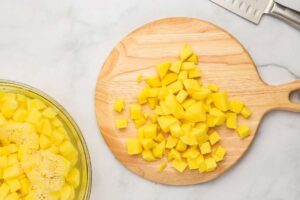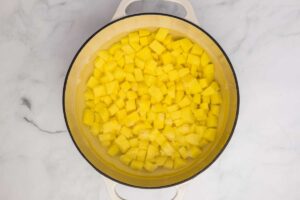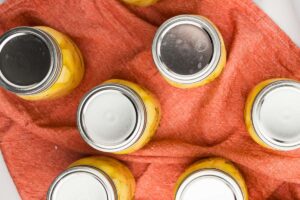Pressure Canned Potatoes Recipe
Makes 8-9 pints of simple, shelf-stable canned potatoes.
Equipment
- Canning jars (pint or quart), lids, and bands
- Large pot (for boiling potatoes)
- Jar lifter
- Canning funnel
- Bubble remover tool (or non-metallic spatula)
- Clean cloths or paper towels
- Potato peeler and knife
- Cutting board
- Pressure canner (adjust pressure for altitude if needed)
Ingredients
- 10 pounds potatoes (choose a variety that will hold its shape well when diced, like Yukon Gold)
- Fresh water for boiling and canning
- Canning salt (optional, 1/2 teaspoon per pint or 1 teaspoon per quart)
Instructions
- Prepare your jars and canner. Wash your canning jars, lids, and bands in hot, soapy water and rinse well. Keep the jars hot until needed by placing them in a simmering water bath or a heated dishwasher. Then, prepare the pressure canner per the manufacturer’s instructions, filling it with 2-3 inches of water. Start heating on low—this preheating step helps reduce the time it takes for your canner to reach pressure later.

- Prep the Potatoes. Wash the potatoes thoroughly to remove dirt. Then, peel the potatoes if desired (peeling is recommended for the best results). Next, cut the potatoes into even, bite-sized pieces to make sure uniform cooking and canning. Place the cut potatoes into a large bowl of cold water to prevent browning while cutting the rest.

- Blanch the potatoes. Drain the potatoes from the cold water and transfer them to a large pot. Then, cover the potatoes with fresh water and bring the pot to a boil. Boil for 2 minutes—this blanching step makes sure the potatoes are heated through and ready for safe preservation.

- Fill the jars. Pack the hot potatoes into your prepared hot jars using a slotted spoon, leaving 1 inch of headspace at the top. If you're using salt, add ½ teaspoon per pint or 1 teaspoon per quart at this stage. Then, ladle boiling water over the potatoes, maintaining the 1-inch headspace. Next, use a bubble remover tool or a non-metallic spatula to gently slide between the potatoes and the jar wall to release any trapped air bubbles. Adjust the headspace if necessary.

- Place the lids and process the jars. Wipe the rim of each jar with a clean, damp cloth or paper towel to make sure a proper seal. Then, place the lids on the jars, then screw the bands on until they are fingertip-tight (don’t overtighten). Place the filled jars on the rack in your preheated pressure canner, making sure the jars are not touching each other. Lock the canner lid in place. Turn the heat to medium-high and allow the canner to vent steam for 10 minutes before placing the weight or closing the vent to bring the canner up to pressure.

- Process the jars. For pint jars, process for 35 minutes at 10 pounds of pressure. For quart jars, process for 40 minutes at 10 pounds of pressure.Note: Adjust the pressure for your altitude according to your pressure canner manual guidelines.After processing, turn off the heat and let the canner depressurize naturally. Do not attempt to speed up this process.

- Cool and store the jars. Once the pressure has returned to zero, carefully unlock the canner and remove the lid. Use a jar lifter to remove the jars from the canner, placing them on a towel or cooling rack. Make sure there is space between each jar. Allow the jars to cool undisturbed for 12-24 hours. Do not tighten the bands or check the seals until the jars are completely cool.

Notes
Before you start canning, it’s a good idea to check that all your canning stuff is working right. Look over your pressure canner’s seal and gauge, if it has one, and make sure your lids and jars are okay. Even a tiny problem with your gear can mess things up later, so checking everything first is smart.
When picking potatoes for canning, go for types like Yukon Gold, Red, or Yellow potatoes because they keep their shape after being canned. Try to stay away from Russets since they can get soft and mushy in the jar.
If you’re in a rush, get your potatoes peeled and chopped the night before and keep them in cold water in the fridge. This stops them from turning brown and saves you time the next day.
If the water from your tap is really hard or smells like chlorine, it might change how your canned potatoes taste. Using filtered or bottled water for boiling and filling the jars can keep the taste clean and fresh.
After you fill the jars, gently use a plastic or wooden tool to remove any air bubbles. Air bubbles can mess up how well your potatoes are canned and cause sealing problems.
Once you’re done processing, let the pressure canner cool and release pressure by itself. Opening it too soon can lead to broken jars or spills.
It’s easy to lose track of when you canned something, so remember to label your jars with what’s inside and the date. You should use home-canned potatoes within a year for the best quality.
And don’t just think about using canned potatoes as a side dish. They’re great in soups, stews, casseroles, or mashed for a quick meal during the week. They help you save time when you need a filling dish fast.
Nutrition
Calories: 388kcal | Carbohydrates: 88g | Protein: 10g | Fat: 0.5g | Saturated Fat: 0.1g | Polyunsaturated Fat: 0.2g | Monounsaturated Fat: 0.01g | Sodium: 30mg | Potassium: 2122mg | Fiber: 11g | Sugar: 4g | Vitamin A: 10IU | Vitamin C: 99mg | Calcium: 60mg | Iron: 4mg
Servings: 9 pints
Calories: 388kcal